Creating a habitat garden is a rewarding way to support biodiversity while adding beauty to your landscape.
In this listicle, we explore 22 stunning wildlife-friendly flowering shrubs that not only bring vibrant colors to your garden but also attract essential pollinators like birds and bees.
Let’s get inspired to transform our outdoor spaces into lush havens for nature’s most important creatures!
1. Butterfly Bush (Buddleja davidii)

The Butterfly Bush (Buddleja davidii) serves as a remarkable attraction for pollinators, drawing in butterflies and bees with its delightful, fragrant tubular flowers that bloom from summer through fall.
This resilient shrub can grow up to 12 feet tall, making it a stunning focal point in any garden. With its vibrant purple, pink, or white flowers, it creates a beautiful contrast against lush green foliage, inviting a variety of wildlife to visit.
To ensure your Butterfly Bush thrives, plant it in a sunny location with well-drained soil. For the best results, consider using Organic Gardening Soil to nourish your plants, or start your garden journey with Butterfly Bush Seeds. Additionally, enhancing your garden’s ecosystem can be made easier with a Pollinator Habitat Garden Kit, ensuring your space is a vibrant haven for both colors and buzzing activity.
2. Summersweet (Clethra alnifolia)

Summersweet, or Clethra alnifolia, is a charming shrub that flourishes in moist, acidic soils, making it an excellent choice for naturalizing near ponds or within woodland gardens.
Its elegant spikes of creamy white to pink flowers bloom in mid-summer, releasing a sweet fragrance that draws in a variety of pollinators, including bees, butterflies, and hummingbirds. To ensure your Summersweet thrives, consider using a high-quality Moisture Control Potting Mix that helps maintain the moisture levels this plant loves.
With its glossy green foliage and stunning autumn color, Summersweet provides year-round visual interest, making it a perfect addition to any garden aimed at enhancing biodiversity. For more tips on selecting the right plants for your space, check out a helpful Native Plant Guide.
3. Spicebush (Lindera benzoin)

Spicebush (Lindera benzoin) is an exceptional addition to any wildlife garden, celebrated for its aromatic leaves and vibrant yellow flowers that bloom in early spring.
This deciduous shrub thrives in partial shade and serves as an essential food source for pollinators, attracting them before many other plants have started to flower.
As the seasons change, the berries that develop after flowering become a vital food source for birds during the fall, showcasing Spicebush’s role as a multi-season delight that supports diverse wildlife.
To enhance your garden’s appeal to these creatures, consider adding a bird feeder to provide additional nourishment for the feathered friends that visit your Spicebush.
4. Flowering Quince (Chaenomeles speciosa)
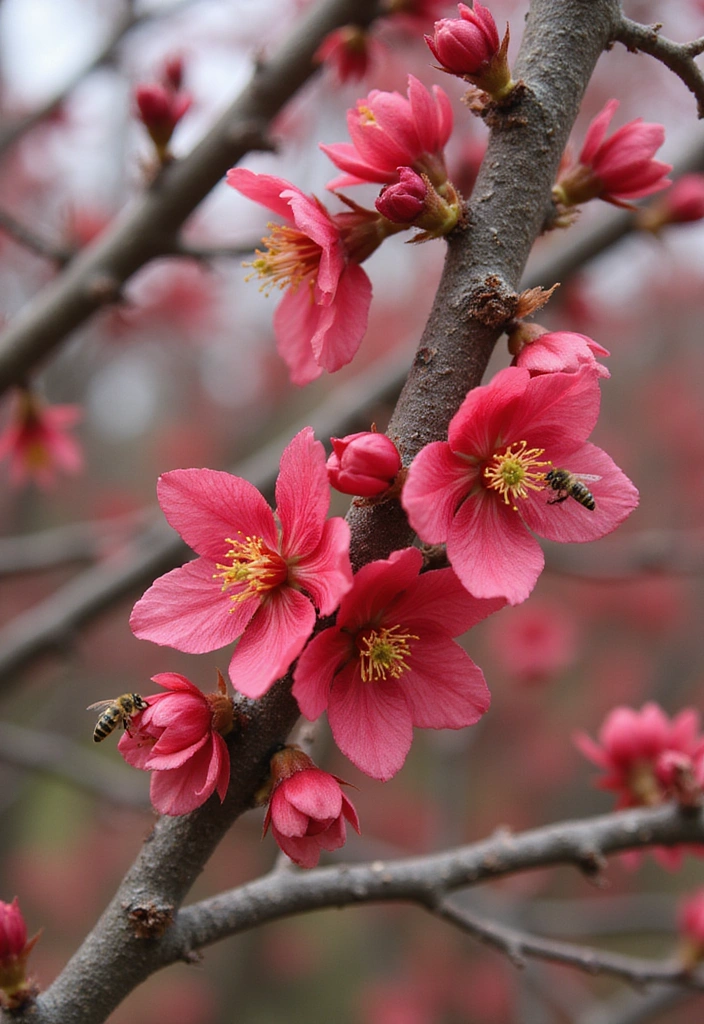
Flowering Quince (Chaenomeles speciosa) is a resilient shrub celebrated for its striking blooms that come in vibrant shades of red, pink, and white.
These beautiful flowers emerge in early spring, serving as a crucial nectar source for bees that are awakening from their winter slumber.
In addition to its aesthetic appeal, the shrub features thorny branches that provide essential shelter for birds, making it an excellent dual-purpose addition to your wildlife habitat garden.
To maintain the health and shape of your Flowering Quince, consider using pruning shears for effective trimming.
And to attract even more feathered friends, you might want to install a cozy birdhouse nearby, enhancing the natural beauty and biodiversity of your garden space.
5. Smokebush (Cotinus coggygria)

Smokebush (Cotinus coggygria) is a visually stunning ornamental shrub that captivates with its unique, fluffy flower clusters. Not only does it serve as a beautiful focal point in any garden, but it also plays a vital role in supporting local wildlife.
The small, delicate flowers of the Smokebush are particularly attractive to bees, making it an essential addition for pollinator-friendly gardens. Additionally, its dense foliage provides essential cover and shelter for birds, creating a safe haven for them to thrive.
As autumn approaches, Smokebush transforms with breathtaking color, adding drama and interest to your landscape while promoting biodiversity. To enhance your garden’s appeal and support even more wildlife, consider incorporating a Butterfly Garden Kit that can attract butterflies and other pollinators. With these thoughtful additions, your garden can become a vibrant sanctuary for both plants and animals.
6. Red-Flowering Currant (Ribes sanguineum)
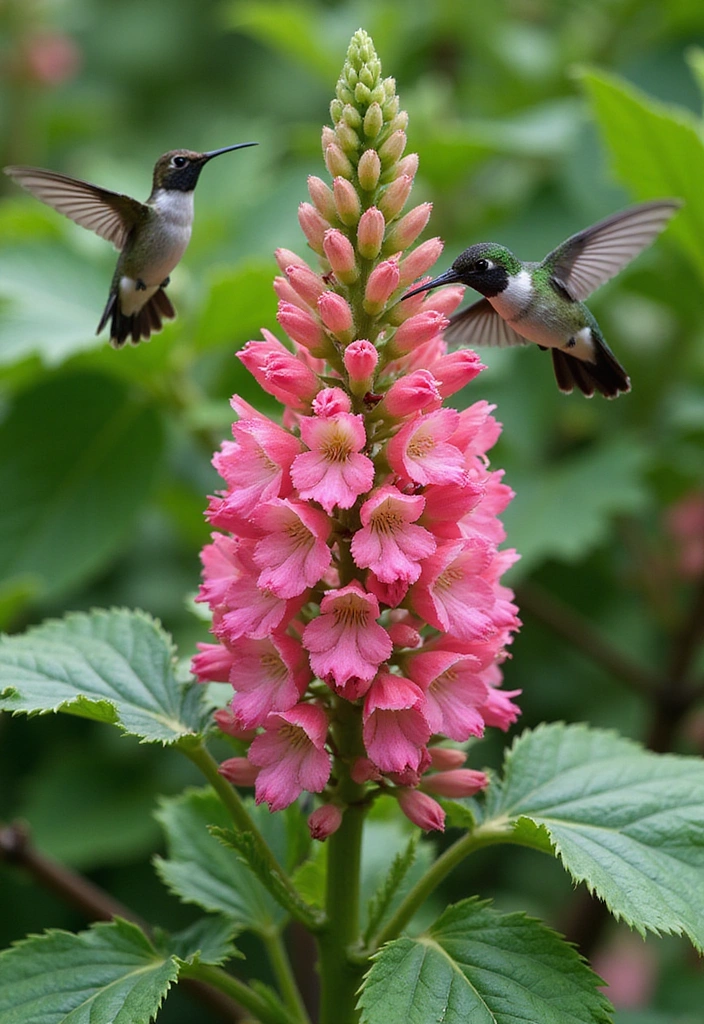
The Red-Flowering Currant (Ribes sanguineum) is a stunning native shrub that showcases beautiful clusters of pink to red flowers in early spring. This vibrant display not only enhances the beauty of your garden but also attracts hummingbirds and bees, making it an essential component of a wildlife-friendly landscape.
To ensure your Red-Flowering Currant thrives, consider using an organic fertilizer that can provide the nutrients it needs to flourish.
As the blossoms give way to edible berries, these fruits become a delightful treat for birds and can even be harvested for human enjoyment. For those looking to expand their berry collection, a berry planting kit can help you cultivate a variety of delicious berries in your garden.
Additionally, to attract even more hummingbirds to your outdoor space, consider providing a hummingbird nectar feeder, ensuring these beautiful creatures have a reliable food source. With these additions, your garden will become a true haven for wildlife!
7. Hydrangea (Hydrangea spp.)

Hydrangeas are cherished flowering shrubs that add a vibrant touch to any garden with their impressive, globe-shaped flower clusters.
These stunning plants not only attract butterflies and bees but also offer essential shelter for birds and small wildlife, making your garden a sanctuary for various creatures.
To keep your Hydrangeas thriving, consider using organic Hydrangea fertilizer to nourish them effectively.
Additionally, incorporating a bird bath nearby will create a refreshing spot for birds to visit, enhancing the wildlife-friendly atmosphere of your garden.
Finally, to further attract butterflies, you may want to use a butterfly attractant, ensuring that your garden is buzzing with life and color.
8. Common Elderberry (Sambucus nigra)
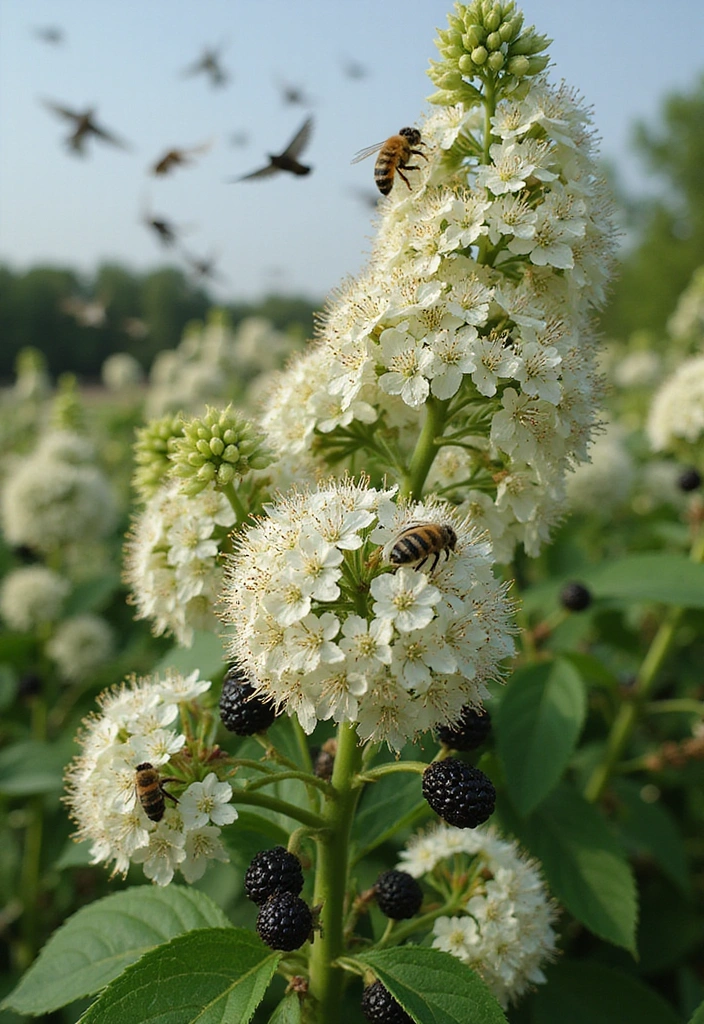
The Common Elderberry (Sambucus nigra) is an exceptional shrub that not only enhances the beauty of your garden but also serves as a vital food source and habitat for various wildlife. Its delightful, fragrant white flowers are particularly appealing to bees, promoting pollination in your garden ecosystem.
Once the flowering season is over, the shrub produces dark berries that provide essential sustenance for birds and other wildlife, making it a haven for nature lovers. To make the most of your elderberry harvest, consider using berry harvesting tools, which can simplify the process of collecting these nutritious fruits.
Additionally, to ensure your elderberry thrives, using an organic fertilizer can promote healthy growth and vibrant blooms. If you’re looking to create a more inviting environment for birds, consider adding birdhouse kits nearby, allowing your feathered friends to settle in and enjoy the bounty this shrub provides. Overall, the Common Elderberry is an excellent choice for gardeners hoping to enhance biodiversity and support local wildlife.
9. Weigela (Weigela florida)

Weigela, or Weigela florida, is an enchanting flowering shrub renowned for its delightful bell-shaped blooms that grace gardens in late spring and early summer.
These vibrant flowers serve as a beacon for hummingbirds and bees, making Weigela an essential addition to any wildlife-friendly garden. To keep your Weigela thriving, consider using a Flowering Shrub Pruning Guide to ensure proper care and maintenance.
With its gracefully arching branches and lush foliage, Weigela not only enhances the beauty of your landscape but also offers vital habitat for local wildlife. To further support your garden’s ecosystem, you might want to use an Organic Bee-Friendly Pesticide to protect your plants without harming beneficial insects.
And for an added touch to attract even more hummingbirds, consider placing a Hummingbird Feeder nearby, creating a true haven for these beautiful creatures.
10. Virginia Sweetspire (Itea virginica)

Virginia Sweetspire is a stunning shrub renowned for its fragrant white flowers that bloom during the spring and summer months. These beautiful blossoms are particularly attractive to bees and other essential pollinators, making it a perfect choice for any wildlife-friendly garden.
In addition to its visual appeal, the dense foliage of Virginia Sweetspire provides crucial shelter for birds throughout the year, creating a welcoming environment for various avian species. To enhance your garden’s biodiversity, consider utilizing a Rain Garden Planting Guide to help you design an effective rain garden or optimize areas with poor drainage.
Furthermore, adding a bird feeder can attract even more feathered friends, while incorporating organic soil amendments will ensure your Virginia Sweetspire thrives in its environment, adding both beauty and functionality to your landscape.
11. Ninebark (Physocarpus opulifolius)
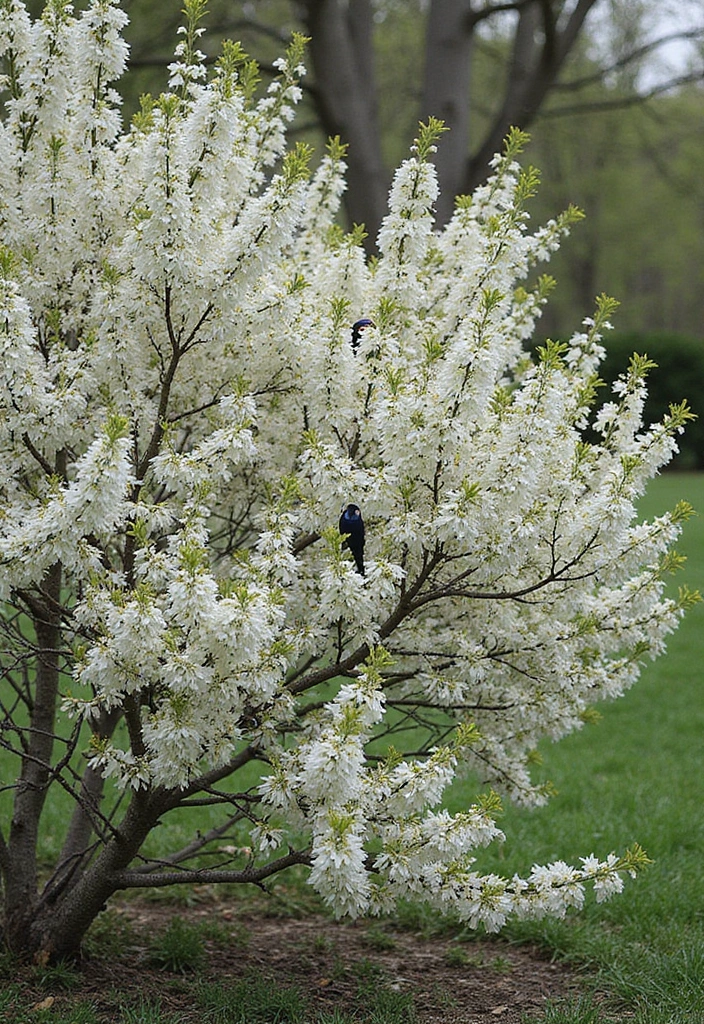
Ninebark (Physocarpus opulifolius) is an incredibly adaptable shrub, known for its striking decorative bark and beautiful clusters of white or pink flowers that bloom in late spring.
The dense foliage not only enhances the visual appeal of your garden but also provides excellent cover for birds, creating a safe haven for them. Additionally, the flowers serve as a vital source of nectar for bees and butterflies, making it a fantastic choice for attracting pollinators.
For those looking to cultivate a wildlife-friendly garden, a Native Plant Care Guide can provide essential tips on how to care for your ninebark and other native plants.
Enhancing your garden’s appeal can also be achieved with a stylish bird bath, which will attract feathered friends to your green space, while using organic gardening supplies ensures that your garden remains a safe environment for all its inhabitants.
12. Crape Myrtle (Lagerstroemia indica)

Crape Myrtle (Lagerstroemia indica) is a breathtaking flowering shrub that brings a burst of vibrant color to your garden throughout the summer months.
Its beautiful blooms are not only visually appealing but also serve as a magnet for bees, butterflies, and hummingbirds, fostering a lively and dynamic atmosphere in your outdoor space.
Moreover, Crape Myrtle is well-suited for hot climates and exhibits impressive drought resistance, making it an excellent choice for those aiming to cultivate a stunning and wildlife-friendly habitat.
For those interested in enhancing their gardening skills and knowledge, consider checking out this Drought-Resistant Planting Guide. Additionally, to attract even more pollinators to your garden, you may want to explore this delicious Butterfly Nectar.
13. Forsythia (Forsythia x intermedia)
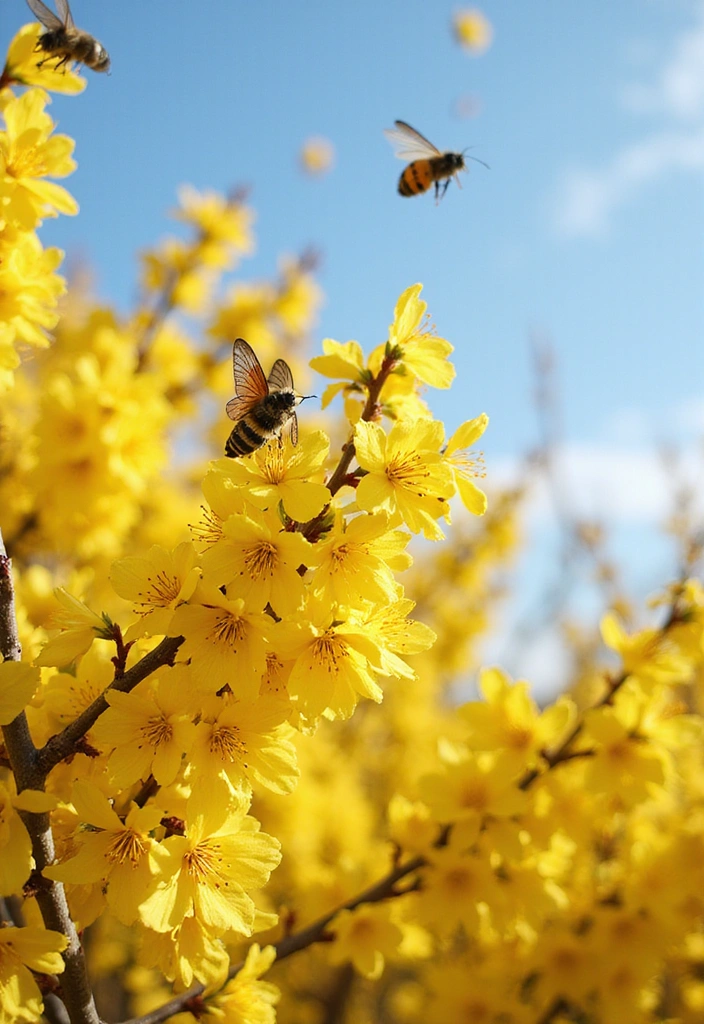
Forsythia, known for its vibrant yellow flowers, is among the first shrubs to herald the arrival of spring, bringing a splash of color and cheer to any garden.
These early blossoms serve as a crucial food source for bees and butterflies that are emerging from their winter slumber, making this shrub a wonderful addition for supporting local wildlife.
In addition to its fast growth and arching branches that create visual interest, you can enhance your garden’s appeal further by planting a Pollinator-Friendly Seed Mix for even more blooms that attract beneficial insects.
To ensure your plants thrive, consider using Organic Mulch to retain moisture and suppress weeds, creating the perfect habitat for your forsythia and other wildlife-friendly plants.
14. Beautyberry (Callicarpa americana)
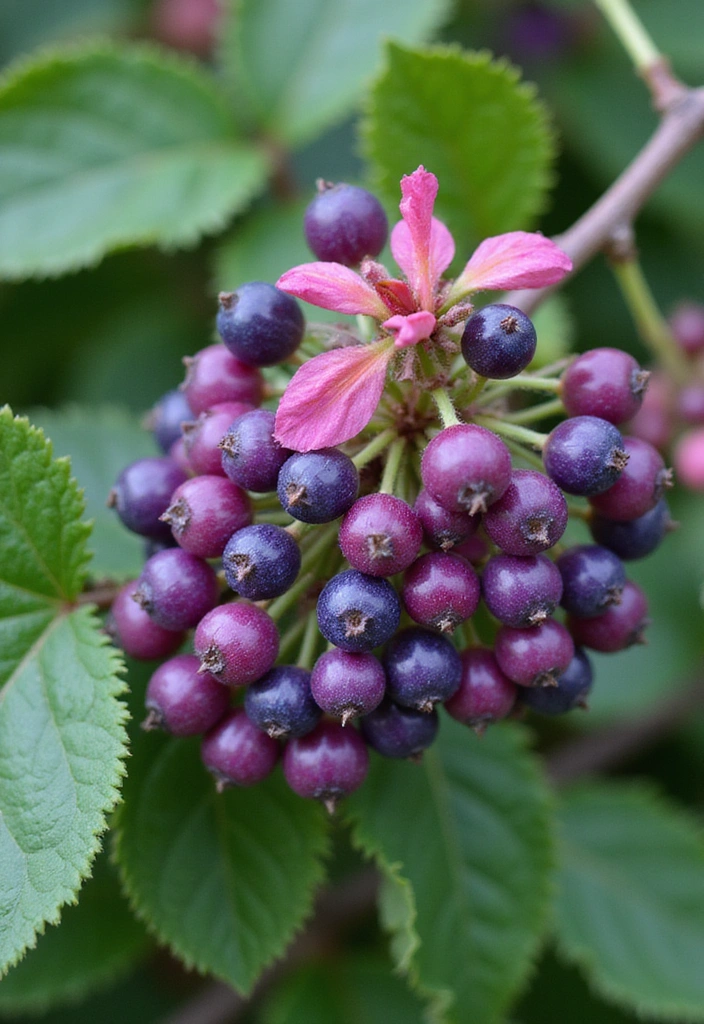
Beautyberry (Callicarpa americana) is an eye-catching shrub, particularly renowned for its vibrant purple berries that emerge in late summer.
In spring, it dazzles with small pink flowers that attract a variety of pollinators, making it an essential addition to any wildlife-friendly garden.
As the seasons change, the berries serve as a crucial food source for birds in the fall, ensuring that this shrub remains a vital part of the ecosystem year-round.
To make the most of your beautyberry harvest, consider investing in berry harvesting tools for an efficient gathering experience.
Additionally, using organic fertilizer can help support the growth of this beautiful shrub, enhancing its flowering and berry production.
And to attract even more feathered friends to your garden, you might want to explore birdhouse kits that can provide safe nesting spots for birds that enjoy the bounty of beautyberry.
15. Lilac (Syringa vulgaris)
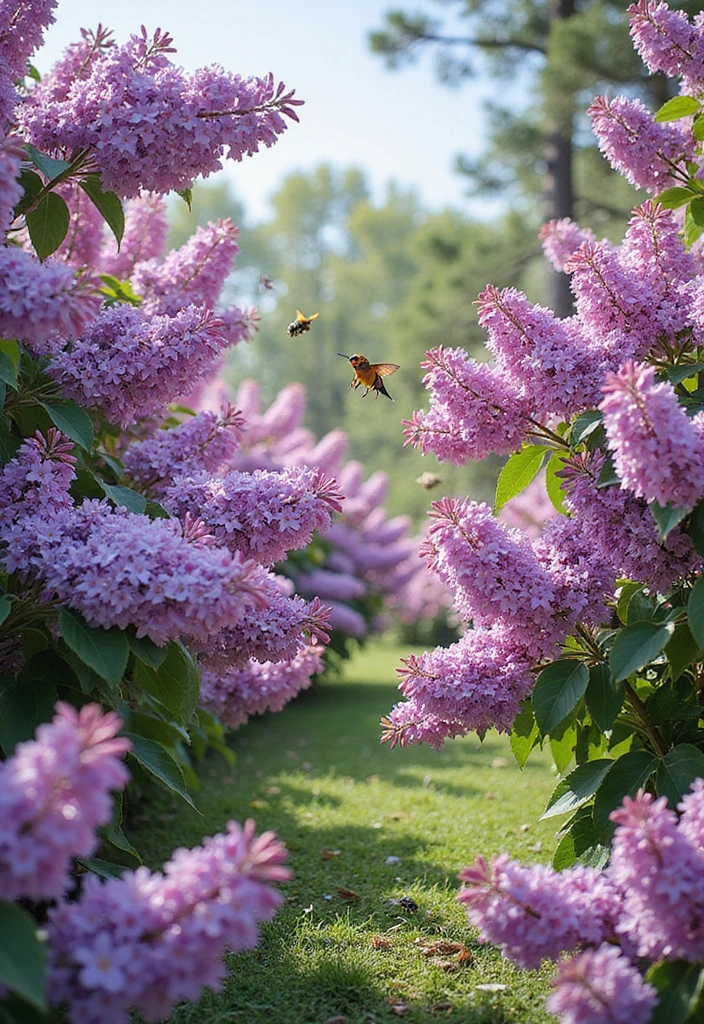
Lilac (Syringa vulgaris) is a timeless flowering shrub, celebrated for its captivating fragrance and stunning clusters of flowers that come in shades of purple, pink, and white.
These vibrant blooms not only enhance the beauty of any garden but also serve as a vital food source, attracting bees and butterflies that play a crucial role in pollination.
To ensure your lilacs thrive and continue to provide a sanctuary for pollinators, consider using organic flower fertilizer.
With its sprawling growth habit and breathtaking spring display, lilac is an excellent choice for creating a wildlife-friendly garden that benefits both you and the local ecosystem.
16. Chokeberry (Aronia spp.)

Chokeberry (Aronia spp.) is an exceptional shrub that showcases stunning white flowers during the spring, followed by an abundance of edible berries in the fall.
These lovely flowers play a vital role in attracting essential pollinators like bees and butterflies, while the nutritious berries serve as a food source for birds and other wildlife, enhancing the biodiversity of your garden.
To fully enjoy the benefits of Chokeberry, consider investing in berry harvesting supplies to make the collection of those delicious berries easier.
Additionally, using organic fertilizer will help promote healthy growth, ensuring your Chokeberry thrives in various soil conditions.
For those looking to expand their knowledge on native plants, a native plant guide can provide valuable insights for enhancing your habitat garden.
17. Snowberry (Symphoricarpos albus)
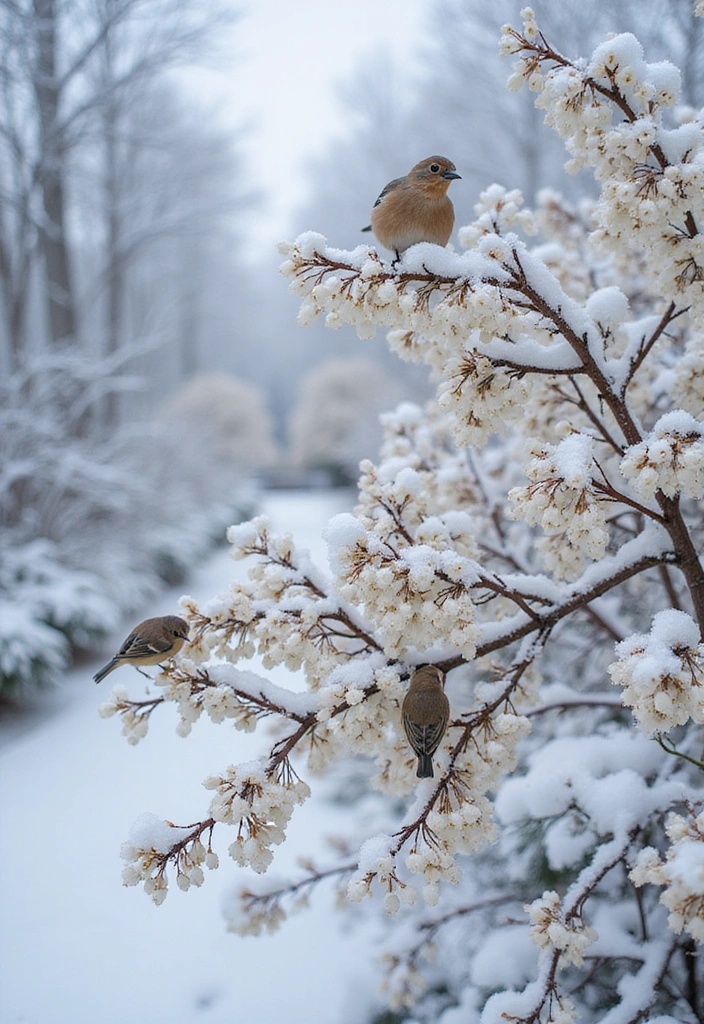
Snowberry, or Symphoricarpos albus, is an enchanting shrub celebrated for its striking white berries that remain through the winter months, offering a vital food source for birds during the colder season.
In the spring, its small yet charming flowers draw in bees, playing an essential role in supporting pollinators. The dense foliage not only provides shelter for various wildlife but also creates a thriving habitat in your garden.
For those looking to enhance their wildlife garden, consider using a Winter Wildlife Habitat Kit to attract and support local fauna. Additionally, incorporating Organic Soil Amendments can help ensure your snowberry and other plants flourish in a variety of soil types.
Don’t forget to add bird feeders to your garden to provide extra nourishment for birds, making your outdoor space a true haven for wildlife.
18. Serviceberry (Amelanchier spp.)

Serviceberry, known scientifically as Amelanchier spp., is a versatile shrub that enchants garden enthusiasts with its striking white flowers in spring. In the summer, it produces delightful edible berries, which are a favorite treat for various bird species and other wildlife, making it an ideal addition for those looking to promote biodiversity in their gardens.
To make the most of your berry harvest, consider using berry harvesting tools that can help you easily collect the fruits.
In addition to its ecological benefits, Serviceberry boasts stunning fall foliage that adds vibrant color to your landscape. Boost its growth and flowering potential with organic fertilizer, ensuring your shrub remains healthy and lush.
To enhance your garden’s appeal to feathered friends, consider adding birdhouse kits nearby, providing safe nesting options for birds that are drawn to the berries. Overall, Serviceberry not only beautifies your yard but also contributes significantly to the local ecosystem.
19. Japanese Barberry (Berberis thunbergii)

Japanese Barberry (Berberis thunbergii) is a resilient shrub that showcases stunning bright yellow flowers in the spring and produces vibrant red berries in the fall.
This versatile plant not only provides essential shelter for birds but also attracts a variety of pollinators, making it a valuable addition to any wildlife-friendly garden.
However, it’s important to choose native varieties to ensure that you are supporting local ecosystems effectively.
With its adaptability to various growing conditions, Japanese Barberry can be an excellent choice for those looking to create a haven for wildlife. For more information on selecting suitable native plants, consider checking out the Native Plant Guide.
20. Honeyberry (Lonicera caerulea)

Honeyberry (Lonicera caerulea) is a remarkable deciduous shrub that delights with its sweet, edible blue berries, which ripen in early summer.
Not only does this plant provide delicious fruit for humans, but its flowers also serve as a vital nectar source for bees and other pollinators, making it an invaluable addition to any wildlife-friendly garden.
To make the most of your Honeyberry harvest, consider investing in berry harvesting supplies to effortlessly gather the fruits.
Enhancing the soil with organic fertilizer can promote healthy growth and abundant yields, while a pollinator habitat kit can further support the local ecosystem by attracting more beneficial insects.
By incorporating Honeyberry into your landscape, you are not only contributing to biodiversity but also enjoying the fruits of your labor!
21. Wild Blueberry (Vaccinium angustifolium)
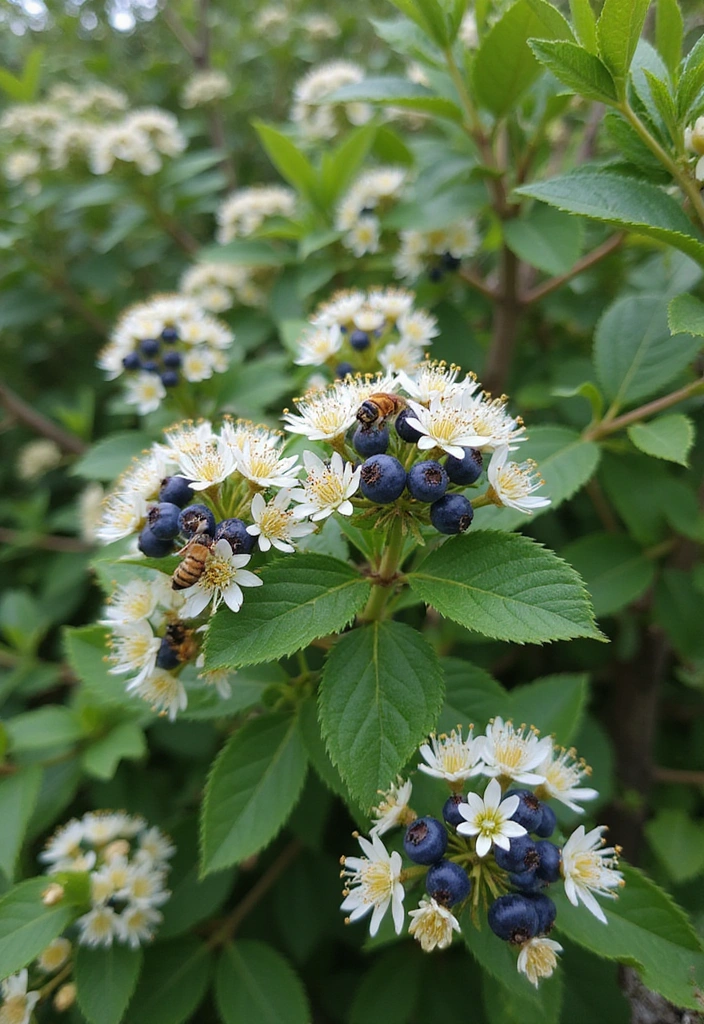
The Wild Blueberry (Vaccinium angustifolium) is a resilient shrub known for its delectable berries and stunning flowers, making it a magnet for various wildlife.
In spring, the blossoms serve as a crucial food source for both bees and butterflies, while the resulting berries are a delightful treat for birds and a nutritious snack for humans.
This versatile shrub flourishes in acidic soils, making it an ideal addition to your habitat garden that promotes biodiversity. To ensure your Wild Blueberries thrive, consider using organic berry fertilizer to enrich the soil.
When it’s time to harvest, having the right tools is essential, so check out these berry harvesting tools for an efficient pick.
For those interested in nurturing native plants, a native plant care guide can provide valuable insights on how to best care for your Wild Blueberry and other flora in your garden.
22. Potentilla (Potentilla fruticosa)

Potentilla, commonly referred to as cinquefoil, is a delightful low-maintenance shrub that enchants gardens with its vibrant yellow, orange, or red flowers during the summer months.
These cheerful blooms serve as a magnet for bees and butterflies, fostering a lively and buzzing environment that supports local wildlife.
In addition to its resilience in various soil types, Potentilla makes for an effortless choice for those aiming to create a thriving wildlife habitat garden. To further enhance the growth of your Potentilla, consider using organic fertilizer that nourishes the soil naturally.
Moreover, providing a safe and inviting space for these pollinators can be achieved with a bee habitat kit, ensuring that your garden remains a sanctuary for these essential creatures.
Conclusion
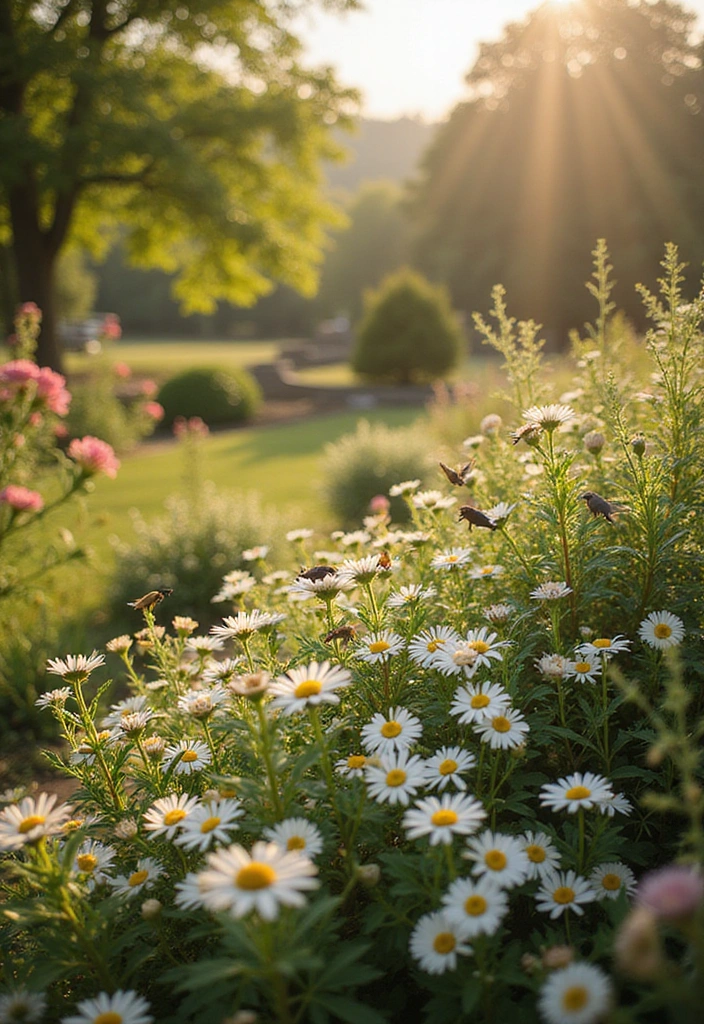
Incorporating wildlife-friendly flowering shrubs into your garden is an impactful way to support biodiversity and create a thriving habitat for birds and bees.
By choosing a variety of these stunning plants, you can transform your outdoor space into a sanctuary for wildlife while enjoying the beauty they bring.
Let’s nurture our landscapes and promote a harmonious relationship with nature!
Note: We aim to provide accurate product links, but some may occasionally expire or become unavailable. If this happens, please search directly on Amazon for the product or a suitable alternative.
This post contains Amazon affiliate links, meaning I may earn a small commission if you purchase through my links, at no extra cost to you.

